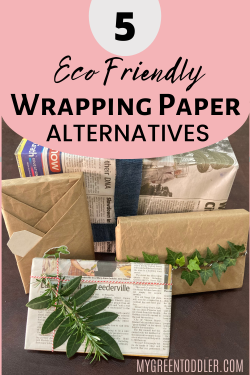Wrapping presents is a common tradition that adds an element of surprise and excitement to gift-giving occasions. However, the environmental impact of traditional wrapping paper can be significant, as it often ends up in landfills and contributes to deforestation. Fortunately, there are many eco-friendly alternatives available that can help reduce waste and promote sustainable practices. In this article, we will discuss how to select eco-friendly wrapping options to make your gifts both beautiful and environmentally conscious.
Understanding the Environmental Impact of Traditional Wrapping Paper

Before we delve into alternative options, it's important to understand the environmental impact of traditional wrapping paper. Most wrapping paper is made from virgin wood pulp, which is obtained by cutting down trees. This process not only contributes to deforestation but also requires a considerable amount of energy and water. Furthermore, shiny or glittery wrapping paper is often coated with non-biodegradable materials, making it difficult to recycle.
Moreover, traditional wrapping paper is usually only used once before being thrown away, adding to the already massive amount of waste generated during the holiday season. According to Stanford University, the United States alone produces around 4 million tons of wrapping paper waste each year, enough to cover 5,787 football fields. This waste then ends up in landfills, where it takes hundreds of years to decompose, releasing harmful greenhouse gases in the process.
With this in mind, let's explore some eco-friendly wrapping options that you can use for your next gift-giving occasion.
Sustainable Wrapping Paper Options

Recycled Wrapping Paper
One of the easiest ways to reduce your environmental impact while wrapping presents is by using recycled wrapping paper. This type of wrapping paper is made from post-consumer waste, such as old newspapers, magazines, or even other types of wrapping paper. Not only does it prevent these materials from ending up in landfills, but it also requires less energy and water to produce.
When purchasing recycled wrapping paper, make sure it is certified by organizations such as the Forest Stewardship Council (FSC) or the Sustainable Forestry Initiative (SFI). These certifications ensure that the paper comes from responsibly managed forests and meets certain environmental and social standards.
Fabric Wraps
Another sustainable option for wrapping presents is using fabric wraps. Fabric wraps, also known as furoshiki in Japanese culture, have been used for centuries to wrap gifts, carry items, and store food. They are typically made from lightweight, durable fabrics such as cotton, linen, or silk and come in a variety of sizes and patterns.
Using fabric wraps not only eliminates waste but also adds a unique touch to your gift. You can even make your own fabric wraps by upcycling old scarves, tea towels, or bed sheets. To use them, simply place your gift in the center of the fabric, gather the sides, and tie a knot to secure it. You can also add embellishments such as ribbons or flowers to make it more festive.
Natural Wrapping Options

Brown Kraft Paper
Brown kraft paper is another eco-friendly option for wrapping presents. It is made from unbleached wood pulp and is 100% biodegradable. Unlike traditional wrapping paper, it does not contain any harmful chemicals or dyes, making it safe to compost. You can also reuse brown kraft paper multiple times before it starts to show signs of wear.
To make your brown kraft paper more festive, you can decorate it with eco-friendly materials such as twine, dried flowers, or stamps. You can also use natural soy-based inks to add a pop of color.
Leaves and Flowers
For a unique and environmentally friendly option, you can use leaves and flowers to wrap your gifts. This option works best for small or delicate items and adds a personal touch to your gift. You can use large leaves such as banana leaves or magnolia leaves, or small flowers like rose petals or lavender. Simply wrap the item in the leaves or flowers and tie it with twine or ribbon.
You can also use larger leaves or flowers as wrapping paper by sandwiching the gift between two layers and securing them together with tape or string. This option not only eliminates waste but also makes your gift stand out.
Reusable Wrapping Options

Gift Bags
Gift bags are a popular alternative to traditional wrapping paper, and they can be reused multiple times. When purchasing gift bags, look for ones made from recycled materials or opt for fabric gift bags. You can also make your own gift bags by upcycling old t-shirts or pillowcases.
To make your gift bag more environmentally friendly, avoid using tissue paper or shredded paper fillers, as they are difficult to recycle. Instead, you can use fabric scraps, dried flowers, or even newspaper as filler.
Gift Boxes
Gift boxes are another reusable option for wrapping presents. They come in various shapes, sizes, and designs, making it easy to find one that suits your needs. You can purchase recycled or biodegradable gift boxes or make your own by upcycling cardboard boxes.
To make your gift box more sustainable, avoid using plastic or foam insert trays. Instead, you can use tissue paper, fabric scraps, or even shredded newspaper to cushion your gift.
Frequently Asked Questions

What is the most eco-friendly wrapping option?
The most eco-friendly wrapping options are those that are reusable, recyclable, or biodegradable, such as recycled wrapping paper, fabric wraps, or natural options like leaves and flowers.
Are there any eco-friendly gift wrapping companies?
Yes, there are several eco-friendly gift wrapping companies that offer sustainable options for wrapping presents. Some popular ones include Wrappily,ecojam, and EarthHero.
Can I recycle traditional wrapping paper?
Unfortunately, most traditional wrapping paper is not recyclable due to the shiny or glittery coatings. However, you can check with your local recycling facilities to see if they accept certain types of wrapping paper.
Is eco-friendly wrapping more expensive than traditional wrapping paper?
It depends on the type of eco-friendly wrapping option you choose. Reusable options such as fabric wraps or gift bags may require an initial investment, but they can save you money in the long run. Natural options like leaves and flowers are typically free, making them the most cost-effective option.
Can I use newspaper to wrap my gifts?
Yes, newspaper can make for a great eco-friendly wrapping option. However, avoid using pages with heavy ink or advertisements, as they may contain harmful chemicals.
Conclusion

Wrapping presents does not have to harm the environment. By choosing eco-friendly wrapping options, we can reduce waste and promote sustainable practices. Whether it’s using recycled paper, fabric wraps, or natural materials, there are plenty of alternatives available that can make our gifts both beautiful and environmentally conscious. So let's make the switch to eco-friendly wrapping and do our part in preserving the planet for future generations.



